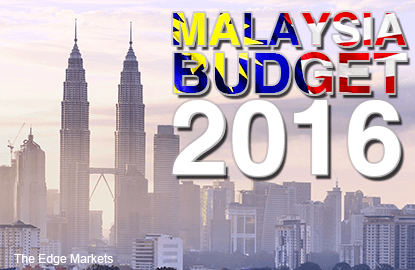
This article first appeared in The Edge Malaysia Weekly, on October 26 - November 1, 2015.
Budget 2016, tabled last Friday by Prime Minister Datuk Seri Najib Razak, does not give much attention to stimulating the local economy even though external and domestic headwinds are expected to gain strength.
The private sector, touted as a key driver of economic growth, did not see significant tax measures that could incentivise consumers and investors to spend and invest more.
Specific tax measures that were announced include a Special Reinvestment Allowance incentive to replace the Reinvestment Allowance that expired. This allows companies in the manufacturing and agriculture sectors to claim 60% of qualifying capital expenditure, which will be set off against 70% of their statutory income for a period of three years.
There are also income tax exemptions for tour operators, an extension of the incentive and a wider scope for food production, and some incentives for the small-medium enterprises.
“We were hoping for a stronger dose [of incentives] given that the economy is not doing great now. We didn’t see many initiatives in terms of promoting our exports, which could have a competitive edge now as the ringgit has depreciated, or initiatives to attract foreign direct investment,” says Yee Wing Peng, country tax leader of Deloitte Malaysia.
Instead of a tax stimulus to help boost economy, tax consultants say the budget appears to be more focused on appeasing the grouses of the middle-income earners who have long complained of being neglected.
For instance, the Goods and Services Tax (GST) zero-rated list grew a little longer. From January 2016, the list of medicines that will be zero-rated will expand cover 8,630 brands, from 4,215 previously.
Basic food items like soybean-based milk and organic-based milk for infant and children, dhal, lotus roo, water chestnut and dried mee kolok, among others, were also added to the list.
Meanwhile, certain industries involved in the reimportation of goods that are exported temporarily for purposes of promotion, exhibition and research were also given relief from GST. This relief is also provided for oil and gas companies for reimported machinery meant for rent and lease.
“These measures are in response to appeals by the industry players. Reimportation shouldn’t have been taxed in the first place. It will make Malaysia more business-friendly and help facilitate transactions,” says Yee.
That said, will the longer list of GST-exempted items impact government coffers?
Royal Malaysian Customs Department Deputy Director General Datuk Subromaniam Tholasy takes the view that it will not.
He says GST collection usually improves year on year due to better compliance and enforcement. “The prime minister mentioned that the expected collection figure will be higher in 2016. We believe that we will improve and whatever shortfall from the newly exempted items will be made up through better enforcement and compliance of traders,” he says.
Apart from these, there seems to be goodies galore in the form of tax relief. However, some do not think these will do much to lighten the people’s burden.
Tax relief for taxpayers with children under 18 years of age will be increased to RM2,000 from RM1,000 previously while taxpayers who have a spouse without income will be given a tax relief of RM4,000, up from RM3,000.
Taxpayers who have children above 18 years of age studying in higher institutions will also enjoy higher tax relief of RM8,000, from RM6,000 previously.
The government also introduced a new tax relief for taxpayers who provide for their parents, giving them RM1,500 for each parent, provided they are 60 years old and above and do not earn more than RM2,000 per month.
“Is there enough to boost economic growth in the budget?” asks Renuka Bhupalan, managing director of tax boutique firm Taxand Malaysia Sdn Bhd.
“The additional tax relief will be popular among the middle-income group, but I don’t think that there will be much tax savings from these increased tax relief,” she says.
Deloitte’s Yee agrees that the tax reliefs announced are unlikely to be enough to make much impact. He adds it is more of a “sentiment pacifier” move rather than providing real material savings for this group.
“What would have been better would be widening the tax band. Currently, if you have chargeable income of between RM50,001 and RM70,000, you are taxed at 16%, whereas in Singapore, a taxpayer earning between S$40,000 and S$80,000 is taxed at 7%. If the tax band in Malaysia is wider, taxpayers would not fall into a higher tax band that quickly,” he says. He acknowledges that the government may not be able to do that now given the current state of the country’s finances.
The bottom 40% group is not left out. BR1M handouts increased by RM50 for each category. Depending on the category, some could receive up to RM1,050.
The total amount to be doled out under BR1M will come up to RM5.9 billion in 2016.
Meanwhile, about RM1.4 billion has been allocated to improve rural roads.
That said, it seems that the bottom 40 group is the biggest winner in Budget 2016 while the middle 40 will continue to feel the burden of the rising cost of living.
Save by subscribing to us for your print and/or digital copy.
P/S: The Edge is also available on Apple's AppStore and Androids' Google Play.